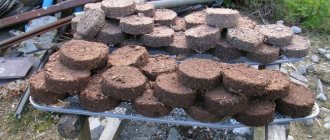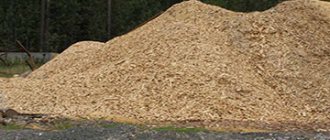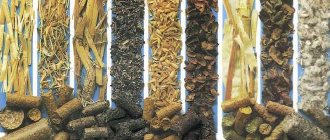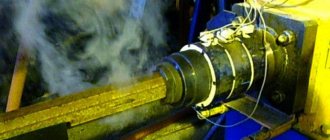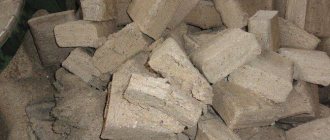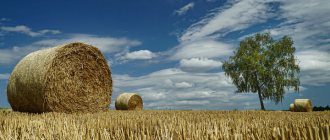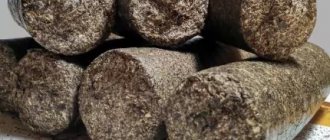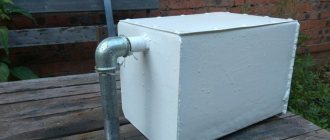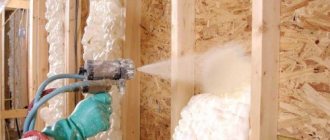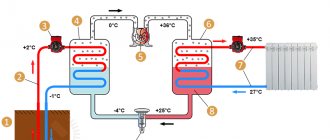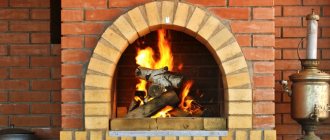Firewood that would burn for a long time, provide a lot of heat and little ash, and would not emit sparks or soot—the dream of the owner of a country house with stove heating or a fireplace. These are the properties that sawdust briquettes have, which you can not only purchase, but also make with your own hands. It is worth familiarizing yourself with the process of their manufacture. It is so?
We will tell you how to make fuel briquettes for use in heating a country house or cottage. The article we have proposed describes in detail the technology for producing logs from pressed sawdust. Do-it-yourselfers will find brief instructions on how to assemble a pressing machine.
Benefits of sawdust logs
The following arguments can be given in favor of briquettes pressed from sawdust:
- Long burning time - 4 hours.
- Minimal smoke generation.
- Environmentally friendly. The starting materials are natural materials, so you can fertilize the beds with ash.
- High energy output. It far exceeds the energy capabilities of firewood and is comparable only to high-quality coal.
- Constant combustion temperature.
- Economical. The cost of 1 ton of such fuel will be cheaper than the corresponding amount of firewood or coal.
- Possibility of self-production.
There are also disadvantages. The main one is the fear of moisture. They cannot be stored in the open air, because... they will quickly absorb moisture and therefore will burn poorly. Therefore, it is necessary to allocate a dry room for storage.
Any significant mechanical impact on sawdust briquettes is contraindicated. If you buy special equipment for their production, the cost will be high and not always justified.
Replacing coal and firewood with sawdust briquettes makes heating a country home more environmentally friendly. While heating with wet wood leads to the release of harmful substances, “Eurowood” is completely safe in this regard
It is profitable to set up handicraft production if the sawdust is free, and you can use existing equipment for installation.
Advantages of pellets over other types of solid fuel
The wide distribution of fuel briquettes, which are also called eurowood and pellets, is due to a whole list of their advantages:
- compact size, which ensures ease of storage and transportation;
- emitting a small amount of smoke and minimal sparking during combustion;
- long burning period (when compared with ordinary firewood, pressed sawdust fuel burns at least twice as long);
- environmentally friendly (compressed from waste materials of natural origin, fuel briquettes do not emit substances harmful to humans and the environment when burned);
- low ash content (the amount of ash formed after complete combustion of pellets does not on average exceed 1% of the total mass of fuel used).
The main advantages of fuel briquettes are long burning and minimum ash
Types of fuel briquettes
Briquettes are divided into types depending on their shape. Mainly the following types can be found on the market:
- RUF. These are pressed rectangles measuring 15 x 9.5 x 6.5 cm. They are made from natural wood sawdust with the addition of special components.
- Nestro. Visually, these are cylinders with a diameter of 6 to 9 cm and a length of 5 to 35 cm, without holes. The material for production is pressed wood pulp. It is dried, placed in a loading container, and then fed through a screw for pressing. Dispensers distribute the mass into molds under pressure.
- Pini kay. In shape they are polyhedra with the number of faces from 4 to 6. During the production process they are subjected to processing at high temperatures and pressing under high pressure, up to 1100 bar. As a result, combustion efficiency, moisture resistance, and density increase.
The chemical composition and heat transfer of all these types of pressed sawdust are the same, they differ only in density. This fuel is not characterized by sparks flying in different directions. Its high density and low hygroscopicity make it possible to store this fuel in a small pantry next to the stove.
In addition to sawdust, sunflower husks, buckwheat, paper, small branches, fallen leaves, and straw are used to produce briquettes. The equipment for this has a fairly simple design, and you can make it yourself
If you have the necessary raw materials to form briquettes, you can make them yourself.
Important process characteristics
Raw material moisture
fuel briquettes pini-kay
The production technology for any briquettes requires drying and grinding of raw materials. If this fact is neglected, then as a result the sintering and gluing reaction when exposed to temperature will be ineffective: the briquette may fall apart at the exit from the briquette.
During manufacturing, you should be able to bring the raw material to a moisture content of 8...14%.
The operation can be neglected if you have piece production (for your own needs in very small volumes). Provided that there is a room, a platform where the raw materials can be dried and stored in a dry state until the press is started.
Be aware of the weather: raw materials stored in damp sheds will be of no use. Before drying wood chips or sawdust naturally, make sure that there is no access to moist air from the street in the area designated for this purpose.
An alternative way to make briquettes is as they do in Africa. Photo selection.
Performance
The volume of briquettes produced directly depends on access to raw materials, sales volumes and own consumption.
To determine the volume, you must at least roughly understand what part of the production will be used for your own needs, and what part will be sold.
- To heat your premises, the number of briquettes can be approximately calculated as ½ of the volume of previously consumed firewood. Read also: why is it more profitable to heat with wood or briquettes?
- Part of the product can be spent on the production process itself - to heat the air during drying (approximately 1...3%).
When calculating productivity, keep in mind that most small companies carry out production before the heating season, after which there is an active surge in sales, and then stagnation sets in on the market: equipment stops, raw materials accumulate. Work resumes only in the spring.
When calculating production volumes, take into account the seasonality factor.
Large companies work more rhythmically: with constant access to raw materials, they produce briquettes all year round. But they trade like everyone else - a month or two before the heating season. After which, the entire briquette produced goes to a warehouse, if there is no other market (or for export to Europe, but Europeans buy in large wholesale).
Investment volume
You can also read the review of manufacturers of equipment for the production of fuel briquettes.
Making fuel briquettes with your own hands using the “roof” or “pinkey” technology is quite expensive at the first stage:
- for micro-businesses, investments are about 2...4 thousand dollars for handicraft production;
- for small and medium-sized businesses, the minimum will have to start from 10 thousand dollars for a small sawmill;
- professional lines for permanent work in this direction cost from 100...130 thousand dollars and more.
Equipment for the production of briquettes
In industrial conditions, the grinding of wood waste is carried out using special mechanisms - crushers. Such an important part of the technological process as drying is performed using drying machines, which come in two types - drum and aerodynamic.
Products are formed using a hydraulic press. With a force of at least 30 MPa, it compacts the mass. At the same time, there is no need to add any substances to the raw material for bonding, because under these conditions, due to compression and high temperature, wood glue - lignin - is released.
Briquettes of any shape can be produced using a mechanical impact press, but their density is not very high.
There is another method for producing “eurowood” - extrusion. It is based on the fact that with a force of about 40 MPa, the mass is pushed through calibrated holes by means of a screw, thereby forming products in the form of cylinders or hexagons. At the exit they are cut with special knives.
The productivity of screw extruders is higher than that of mechanical or hydraulic presses.
Manufacturers often apply a letter imprint to the surface of briquettes produced using industrial equipment. Basically, it is evidence of strict adherence to technology
It is irrational to buy such installations for making your own and preparing fuel briquettes; there are other options for this.
Raw materials
The quality of raw materials will be an important factor in the success of production, so you should take care of the issues of its supply in advance. In our case, the choice of raw materials is quite large, which allows us to produce various types of products.
Finished products await transportation
Currently, the following are used for the production of eco-wood:
- Wood and its waste (leaves, sawdust, shavings, branches). The most popular option, cheap, easy to manufacture, good in performance. The most commonly used wood is pine needles, birch, and oak. The cost of briquettes does not depend on the type of wood, since only waste is used in production. RUF fuel briquettes often consist of 95% of one type of wood and 5% of various impurities, which does not in any way affect the quality of the fuel.
- Straw of grain crops (wheat, corn). The cheapest type of raw material for the cheapest briquettes. When eco-wood from straw burns, not much heat is released, but a large amount of ash remains. You can compare these briquettes with good firewood.
- Peat. Inexpensive raw materials allow you to create fuel briquettes in the middle price range. They produce a decent amount of heat, but they smoke very heavily. Fuel briquettes cannot be used everywhere; special ovens are needed to use them.
- Husks from cereal seeds. An original type of raw material from which dark Eurobriquettes are produced, which, when burned, emit a specific smell and the greatest heat among their fellows. At the same time, the husk contains various substances and oils that form soot on the chimney, which requires regular cleaning. Fuel briquettes made from sunflower husks emit more heat than analogues made from the best wood.
- Walnut shells. A rare and expensive type of raw material, from which good fuel briquettes are obtained. They burn with a beautiful, bright and high yellow flame, which is just right for use in fireplaces.
Well-packaged wood briquettes
In rare cases, the following raw materials are used: reeds, flax processing waste, coal screenings, and grapevines.
For conventional stoves, it is best to choose fuel briquettes made from wood or grain husks.
Good to know: Burning temperature of firewood from different types of wood in the furnace firebox
The main requirements for the raw materials that will be supplied to the plant are the minimum fraction size. This will simplify the technological processes in the production of Eurobriquettes.
Independent production of briquettes
The main supplier of sawdust is the sawmill. It doesn’t matter what type of wood it is, the main criterion is moisture content. It should not go beyond 12%. In the total mass, the amount of spoiled wood should not exceed 5%.
Description of the technological process
This process is not very complicated and generally consists of five stages:
- Purification of raw materials. It is necessary to remove dirt and excess impurities.
- Grinding. The size of the sawdust matters - a maximum of 0.6 cm.
- Pressing.
- Drying.
- Warehousing.
After the first preparatory stage, the mass is mixed with dry, powdered clay, proportion 10: 1. Next, adding a little water, begin mixing. Please note that the thickness of the mixture should be medium. The ability of it to hold its shape, the drying time and the finishing density of the products depend on this indicator.
The next step is loading the resulting mixture into the bunker of the briquetting equipment. Then the actual pressing in molds. After all, all that remains is to dry the finished briquettes well. Cardboard soaked in water is sometimes added to the clay mixture. In this case, the flammability of the fuel increases.
Homemade pressing plants
At home, you can make equipment in three versions:
- with hydraulic drive;
- with manual drive;
- with jacks.
The manual device is the simplest. It can be attached to the wall. The frame for it is made of a steel pipe or angle by welding.
It is impossible to create a full-fledged technological line for the production of briquettes at home, because it is very expensive and requires large areas. Craftsmen at home use homemade machines of various designs
One cannot miss the point that when the sawdust is large, it must be crushed before pressing. A simple cutter is suitable for this, but it is better to mechanize this process. It’s good if you have a machine for grinding grass at home, it will also cope with crushing sawdust.
Some craftsmen adapt outdated washing machines for this purpose. For this purpose, the activator is supplemented with knives.
Manual machine
A press for the production of briquettes from sawdust at home is fixed on the wall with dowels. A stationary form is attached to the lower part of the structure.
Its geometry can be any. To control the mechanism, a lever is needed, so a hinge is mounted on the top crossbar, through which a piece of pipe or a long metal pin is attached.
The mold, installed motionless, will serve as a matrix, and the punch is attached to the lever. It is important to correctly calculate the length of the pipe so that the punch fits freely into the matrix.
For free movement of the punch it is necessary to provide a small gap. To remove moisture from the matrix mold, a hole is drilled in its bottom.
The second option for a manual press is a floor mechanism. Its design is identical to the wall fixture, the only difference is that the welded frame to which the main parts are attached is installed on a flat horizontal surface.
Another type of manually operated equipment is a screw press. It is very easy to use. The lower part is a perforated molding container located under the bed.
When tightening the screw, the pressure necessary for pressing is created. The performance of such a device is very low. A lot of time is spent on loading, tightening the screw, and removing finished products. Lever models have more potential.
Improved homemade version
Manual equipment can be improved by adding a jack or hydraulic press. The shape is made square or round. The base is welded from channel. Racks - corner 100 x 100.
Round shapes are made from thick-walled pipes. The matrix is perforated so that the water released during compression escapes. To remove finished products, the bottom is made removable.
For this purpose, you can install a spring inside the matrix, attaching it to the bottom, but then it must be tightly welded. A disk is attached to the spring. When the product is formed, it contracts, and when the rod reverses, it straightens and pushes the finished briquette out of the mold with a disk.
It is impossible to obtain super-strong products with such an installation, but the briquette will be quite dense, conveniently shaped and quite suitable for use
The rod is made from a pipe with a diameter of about 3 cm. A punch is attached to one end by welding, which fits into the matrix with a small gap. The opposite end of the rod is fixed to a hydraulic jack or press.
Before loading the raw material, it must be mixed well. This requires a special container. They make it from sheet steel or adapt a drum from an old washing machine and install it on racks. You can mix it with a mixer or in a concrete mixer.
From the drum, the wood pulp is supplied for pressing into molds along a tray made of sheet steel. It is best to dry briquettes in an oven, but you can also dry them in the sun. The main thing is that the humidity is minimal. Only a dry type of fuel will give off such an amount of thermal energy that is enough to heat the premises.
Stationary briquetting press
To make such a press, you will need a 2.5 kW motor if you are working on a 220 V network. If three-phase voltage is supplied, a 9 kW motor will do. In addition, you need a gearbox, shaft, bearing, auger, heating elements, and a relay for temperature control.
The engine, gearbox and other components are mounted on a welded frame from an angle. It is installed on racks made of pipes. The auger in this design consists of two parts. One of the bottoms transforms sawdust into a loading container, the second acts as a punch. The role of the matrix is played by the pipe.
As a result of heating the wood pulp and the penetration of steam into it, the plastic viscosity of sawdust increases, which provokes the release of natural binding components. For this reason, sawdust can be loaded into the hopper without any additives
Before starting the press, the pipe is heated using heating elements to 260⁰. Heating is regulated using a relay. The compaction of the briquettes is controlled by a square welded to the pipe. As a design flaw, large heat losses into the environment can be noted. But at the same time, the quality of the briquettes increases significantly.
Do-it-yourself briquetting - pros and cons
It is possible to make a press yourself and set up the production of fuel briquettes. But this requires material costs, physical effort and time. It is also necessary to take into account that it is unlikely that it will be possible to achieve the quality of European firewood produced in factories. Of course, you can purchase a machine that is not much inferior to a production one, but the acquisition costs will be colossal.
You need to have a good idea of why you need your own production, what the conditions are for this, and what the costs will be. Maybe you shouldn’t give up regular firewood or it might be better to buy ready-made briquettes for heating.
pros
The positive aspects of homemade are as follows. Your own fuel briquettes will not provide the same combustion quality as purchased briquettes, but they will be more efficient than firewood.
If it is possible to obtain a large amount of wood waste - sawdust, small trimmings, shavings, bark - then it is more profitable to make compressed firewood from them. Sawdust and shavings in their pure form are of little use for combustion, but after processing on a sawdust pressing machine they produce good fuel.
You can use not only wood, but also any other combustible waste - straw, dry leaves, paper, cardboard. Separately, none of them are flammable material, but briquettes will be useful. Briquetted fuel is convenient for storage and loading into the firebox.
Minuses
But there are also disadvantages to keep in mind. Attempts to improve the quality of home-made European firewood can lead to the purchase of expensive equipment or the constant addition of existing equipment. As a result, it turns out that producing your own briquettes will not justify the costs.
Homemade fuel briquettes require space for proper drying. Drying in the sun is not always justified. A spacious, dry room is required. Homemade briquettes should also be stored so that they do not absorb moisture.
Homemade Bonding Materials
Using homemade machines, it is almost impossible to achieve the pressure at which lignin is released from wood pulp. Therefore, it is necessary to add materials to the raw materials for independent briquetting that will help bind and glue the raw materials into a monolithic briquette. Most often used for these purposes:
- clay. Volume proportion 1 to 10 wood raw materials;
- glue. Any will do, but, naturally, it’s better to take the cheapest one;
- shredded paper or cardboard. In addition to the fact that it is also a flammable material, paper contains lignin. And paper lignin exhibits its adhesive properties when soaked. True, then you will need additional time to dry the briquettes containing paper.
In order for binding additives to fully demonstrate their properties, they must be thoroughly mixed with combustible raw materials, and then this mixture must be soaked in water.
Note! In industrial production, the raw materials are thoroughly dried before pressing, and in homemade production, they are thoroughly soaked.
This is the main difference between homemade ones. Fuel briquettes are dried after pressing so that they harden, hold their shape and burn well.
How to calculate the need for fuel briquettes?
Having decided to switch the heating of your home to sawdust briquettes, it is better to immediately calculate how many of them will be needed to last for the entire period. Here you need to take into account the temperature that needs to be maintained, the area of the room, the thickness of the walls and other factors.
The quality of eco-fuel also plays an important role. The heat output of 1 kg of high-quality briquettes can reach up to 4.4 kW. Products made at home for use in brick ovens or metal bath units will not produce such a result.
Let's say a house with an area of 100 m² is well insulated, the heating period lasts 190 days, the boiler operating coefficient is 0.7. Then 100 x 190 x 24 x 0.7 x 70 = 22,344 kW. If we take into account that the efficiency of the furnace is 86%, the heat transfer will decrease to 3.9 kW. Investigator, you need a supply of briquettes of 22,344: 3.9 = 5.7 tons.
General information about briquetting press
The equipment is produced in a variety of designs. The developed force varies from 500 to 3000 kgf/sq.cm.
Approximate cost in rubles:
- mini presses – 70,000–100,000;
- budget class models – 200,000;
- multifunctional machines with a long service life - from 300,000 to 1,000,000.
A homemade unit can be made at home from scrap materials.
Purpose
The press compresses fine-grained raw materials until they turn into a dense briquette. Expensive models simultaneously heat the source material to a temperature of +150...300°C, which promotes the release of lignin from plant cells.
The press compresses the raw materials into a dense briquette.
Machines designed for the continuous production of Euro firewood cut them into individual bars.
Design features: main elements
The main components of the press:
- Mixer. Mixes several types of raw materials until a homogeneous mixture is achieved.
- Matrix. Gives raw materials the desired shape.
- Punch. Applies pressure on the original mass.
- Operating mechanism with drive. Converts electrical energy into compression force.
- Bed. The base to which all components are attached.
Some models are additionally equipped with a heater and a knife.
Principle of operation
The mixture enters the matrix, where it is subjected to pressure from the punch. The raw material is compacted with simultaneous molding.
Operating principle of a briquette press.
According to the principle of operation, machines are divided into 2 types:
- Intermittent. During production, the cycle is repeated many times: loading of raw materials – compression – removal of the finished product from the mold.
- Continuous (extruders). Adding raw materials and squeezing out the product occurs constantly, while at the same time the latter is cut into bars.
What are the advantages and disadvantages of coal briquettes?
It is impossible to say with certainty that a briquetted corner is the only correct solution for heating a home. But, if we compare briquetted coal with other types of fuel, we can highlight a number of advantages that put this fuel among the leaders. These include:
- burn for a long time and emit a lot of heat,
- identical briquette sizes release heat evenly,
- briquettes are light and compact, which simplifies their transportation and storage,
- a quality product does not emit carbon monoxide, so it can be used in residential areas with good ventilation,
- when produced correctly, coal briquettes do not crumble and do not pollute the room,
- ignite in just 10-15 minutes.
Charcoal briquettes burn for a long time and produce a lot of heat
In addition to the advantages of compressed coal fuel, it is necessary to mention its disadvantages. Briquettes glued with binders cannot be used in barbecues, barbecues and grills. The heat temperature generated by coal may exceed the required temperature and the equipment will fail. Also, some briquettes emit carcinogens that are harmful to the body, with which cooked foods become saturated, becoming unsuitable for further consumption. To use coal as kindling for home stoves, you must follow safety rules when beneficiating and briquetting coal. There is special eco-friendly briquetted coal for barbecues on sale.
Charcoal for barbecue
Pressure and temperature
The quality of briquettes depends not only on the raw materials themselves, but also on two main indicators.
The first is pressure. The strength of the finished product varies significantly depending on the level of compression. A high-quality compressed briquette will maintain its integrity during transportation or storage. Also, more heat is released per kilogram, since the density is very high.
Heat treatment is intended to produce lignin. This substance is released under the influence of high pressure on a heated mass. Once formed and cooled to room temperature, it gains strength.
Useful tips and general recommendations
The creators of homemade briquetting machines advise doing this:
- Start designing with a detailed drawing indicating dimensions. This will avoid mistakes and accurately determine the amount of materials needed.
- Entrust the strength calculations of parts to a mechanical engineer or builder who is well versed in the strength of materials.
- Periodically check the product for bends and distortions and, if found, eliminate them. Otherwise, the quality of the briquettes will suffer.
- Dry the finished bars in the sun or in a ventilated area. This will ensure high calorific value of the fuel.
Using clay as a binder, make sure there is no soil in it. Otherwise, the briquettes will crumble.
Rectangular
Solid fuel from secondary products and waste is classified according to several indicators.
One of them is the shape of the finished product. For rectangular briquettes, presses with a pressure of 300-400 bar are used. They are also called RUF briquettes. This was the name of the first company in Germany that began producing briquetted fuel of this form.
The dimensions of each finished element are almost the same as those of fired bricks. The hydraulic equipment is characterized by simple design and reliable operation. Ready-made brick-shaped briquettes are easy to transport and convenient to store.
